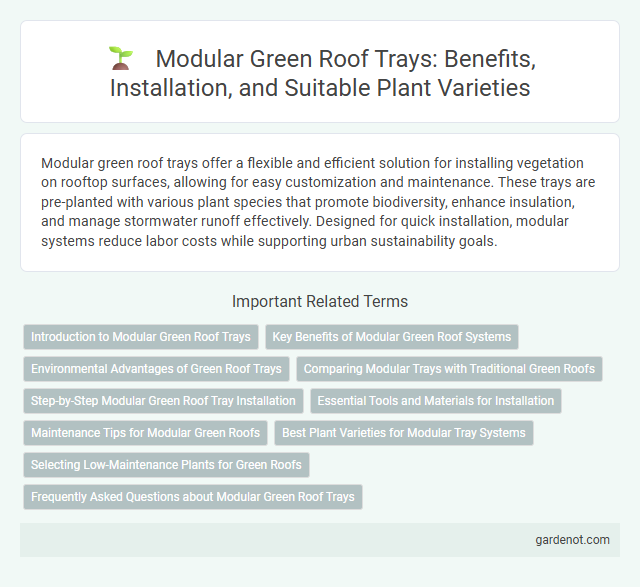Modular green roof trays offer a flexible and efficient solution for installing vegetation on rooftop surfaces, allowing for easy customization and maintenance. These trays are pre-planted with various plant species that promote biodiversity, enhance insulation, and manage stormwater runoff effectively. Designed for quick installation, modular systems reduce labor costs while supporting urban sustainability goals.
Introduction to Modular Green Roof Trays
Modular green roof trays are pre-planted, lightweight units designed to simplify the installation and maintenance of green roofs. These trays typically contain soil, plants, and drainage layers, allowing for rapid assembly and easier customization on rooftops. By using modular trays, building owners can achieve enhanced stormwater management, improved thermal insulation, and increased urban biodiversity efficiently.
Key Benefits of Modular Green Roof Systems
Modular green roof trays offer significant advantages such as easy installation, enhanced drainage, and improved plant health through optimized soil depth control. These systems enable rapid deployment and maintenance, reducing labor costs and minimizing roof damage during installation. Their adaptability to various roof types ensures effective stormwater management and thermal insulation, leading to energy savings and extended roof lifespan.
Environmental Advantages of Green Roof Trays
Modular green roof trays enhance urban biodiversity by providing habitats for various plant and insect species while improving air quality through natural filtration of pollutants. They contribute to energy efficiency by insulating buildings, reducing heating and cooling demands, and mitigating the urban heat island effect. These environmentally advantageous trays also support stormwater management by absorbing rainfall, decreasing runoff, and reducing the risk of flooding.
Comparing Modular Trays with Traditional Green Roofs
Modular green roof trays offer faster installation and easier maintenance compared to traditional green roofs, as each tray is pre-planted and designed for quick placement. These trays provide uniform growing media depth and optimized drainage layers, enhancing plant health and reducing labor costs over time. Traditional green roofs require on-site planting and precise layering, which can increase installation time and complexity, making modular systems more efficient for urban environments.
Step-by-Step Modular Green Roof Tray Installation
Modular green roof trays simplify the installation process by providing pre-planted, lightweight sections that fit together seamlessly on the roof surface. Start by preparing a clean, waterproof roof deck and laying a root barrier membrane before positioning the trays in a grid pattern. Secure each tray to prevent shifting, connect irrigation components if needed, and ensure proper drainage to promote healthy plant growth and system longevity.
Essential Tools and Materials for Installation
Modular green roof trays require essential tools including a utility knife, measuring tape, and a cordless drill with appropriate bits for precise assembly and cutting. Key materials consist of waterproof membranes, drainage layers, growing medium, and pre-planted vegetation modules designed for easy installation and optimal green roof performance. Proper use of these tools and materials ensures durability, effective water management, and healthy plant growth on modular green roofs.
Maintenance Tips for Modular Green Roofs
Modular green roof trays facilitate efficient maintenance by allowing easy replacement and inspection of individual sections, reducing overall disruption. Regular irrigation, weed control, and monitoring for drainage issues ensure optimal plant health and structural integrity. Seasonal cleaning of debris and periodic fertilization support sustained growth and long-term performance of modular green roofs.
Best Plant Varieties for Modular Tray Systems
Sedum species, known for drought tolerance and shallow root systems, are ideal for modular green roof trays due to their low maintenance and rapid coverage. Lightweight grasses such as Festuca and Carex enhance tray stability while providing aesthetic diversity and resilience to wind stress. Incorporating drought-resistant herbs like thyme or rosemary improves biodiversity and supports urban pollinators in modular tray systems.
Selecting Low-Maintenance Plants for Green Roofs
Selecting low-maintenance plants for modular green roof trays ensures long-term sustainability and reduces upkeep costs. Succulents, sedums, and native drought-resistant species thrive in shallow substrates while requiring minimal watering and fertilization. These resilient plants enhance green roof functionality by promoting insulation, stormwater management, and biodiversity.
Frequently Asked Questions about Modular Green Roof Trays
Modular green roof trays streamline installation and maintenance by offering pre-planted, lightweight units that reduce labor costs and improve vegetation establishment. Common questions address tray materials, drainage capabilities, weight load, and compatibility with various building structures to ensure optimal performance and longevity. Understanding irrigation needs, root protection layers, and tray dimensions helps maximize green roof efficiency and environmental benefits.
Modular green roof tray Infographic

 gardenot.com
gardenot.com